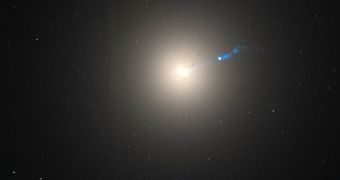According to the discoveries made in a new scientific study, it would appear that the jets produced by black holes are in fact formed much closer to the objects' surface than astronomers first realized. The new data might help researchers gain a better understanding of the phenomenon.
Jets are formed when massive amounts of matter spiral into the black hole, feeding its growth. The intricate physical processes going on tend to produce very high amounts of radio radiation, which special telescopes can then pick up from Earth.
Radio astronomers say that some black holes have clearly distinguishable jets coming out of their poles. Until now, scientists believed that these jets were formed a good distance from the actual surfaces of black holes, but the study proves that is not the case.
The production of radio jets has always perplexed experts. Theoretically, a black hole should engulf all matter and energy around it, not letting anything escape once it passes the event horizon. However, some matter does escape the dark behemoth, especially as radio-wavelength light.
In the new study, experts from the Graduate University for Advanced Studies in Tokyo, Japan, focused their attention on the supergiant elliptical galaxy Messier 87 (M87), which is located about 53.5 million light-years away from Earth.
The black hole that powers up this cosmic structure is 23.5 billion miles (37.8 billion kilometers) in diameter, tipping the scale at over 6 billion solar masses. GUAS astronomer Kazuhiro Hada and his team used the Very Long Baseline Array (VLBA) to study the object.
The expert, who was also the lead author of a new study detailing the findings, says that the cores of the radio jets themselves lay within a hundredth of a light-year of the black hole's surface, which contradicts existing theories on how the jets form.
One of the most popular explanations is that the phenomena are produced by twisting magnetic fields located within the ionized gas swirling around black holes. Past researches had suggested that radio jets forming as a result of this would be located farther away from the object's surface.
Details of the study the team conducted were published in the Sept 8 issue of the top scientific journal Nature. The development of telescopes capable of seeing matter falling into black holes “will be a precious holy grail for modern science,” Hada explains.
The scientist believes that this will become a reality within a few years, when the next generation of space telescopes comes out. Their resolve power will be significantly improved from today's devices, Space reports.

 14 DAY TRIAL //
14 DAY TRIAL //